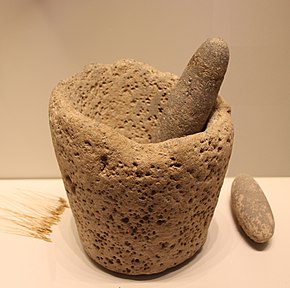
Back العصر الحجري القديم الانتقالي Arabic Epipaleolíticu AST Epipaleolit Azerbaijani Epipaleolític Catalan Pozdní paleolit Czech Epipaläolithikum German Επιπαλαιολιθική περίοδος Greek Epipaleolitiko Esperanto Epipaleolítico Spanish Epipaleolito Basque
 Epipalaeolithic stone mortar and pestle, Kebaran culture, Epipaleolithic Near East. 22000-18000 BP | |
| Alternative names | Mesolithic (for Europe) |
|---|---|
| Geographical range | Near East |
| Period | End of Old Stone Age |
| Dates | 20,000 to 10,000 BP |
| Preceded by | Levantine Aurignacian (Upper Paleolithic) |
| Followed by | Neolithic |
In archaeology, the Epipalaeolithic or Epipaleolithic (sometimes Epi-paleolithic etc.) is a period occurring between the Upper Paleolithic and Neolithic during the Stone Age. Mesolithic also falls between these two periods, and the two are sometimes confused or used as synonyms. More often, they are distinct, referring to approximately the same period of time in different geographic areas. Epipaleolithic always includes this period in the Levant and, often, the rest of the Near East. It sometimes includes parts of Southeast Europe, where Mesolithic is much more commonly used. Mesolithic very rarely includes the Levant or the Near East; in Europe, Epipalaeolithic is used, though not very often, to refer to the early Mesolithic.
The Epipalaeolithic has been defined as the "final Upper Palaeolithic industries occurring at the end of the final glaciation which appear to merge technologically into the Mesolithic".[1] The period is generally dated from c. 20,000 BP to 10,000 BP in the Levant,[2] but later in Europe. If used as a synonym or equivalent for Mesolithic in Europe, it might end at about c. 5,000 BP or even later.
In the Levant, the period may be subdivided into Early, Middle and Late Epipaleolithic, the last also being the Natufian.[3] The preceding final Upper Paleolithic period is the Kebaran or "Upper Paleolithic Stage VI".[3]
Epipalaeolithic hunter-gatherers, generally nomadic, made relatively advanced tools from small flint or obsidian blades, known as microliths, that were hafted in wooden implements. There are settlements with "flimsy structures", probably not permanently occupied except at some rich sites, but used and returned to seasonally.[4]
© MMXXIII Rich X Search. We shall prevail. All rights reserved. Rich X Search